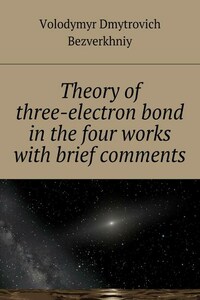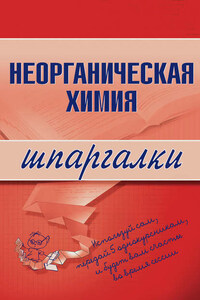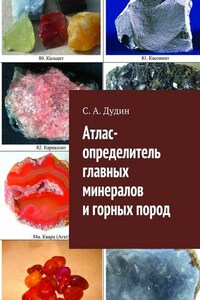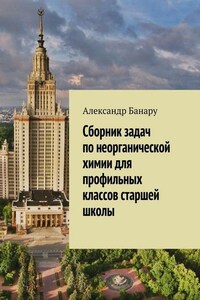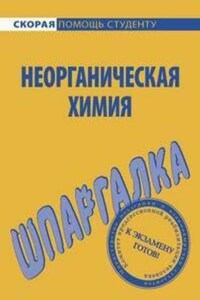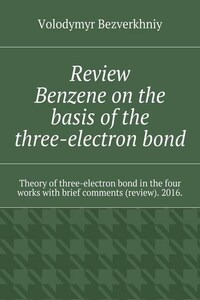I express my deep gratitude to my son, Bezverkhniy Vitaliy Volodymyrovich, for participation in the development of the theory (some parts as a co-author), and for his invaluable contribution to the English translation.
1. Bezverkhniy V. D. Structure of the benzene molecule on the
basis of the three-electron bond.
http://vixra.org/pdf/1606.0152v1.pdf
2. Bezverkhniy V. D. Experimental confirmation of the existence of the three-electron bond and theoretical basis ot its existence.
http://vixra.org/pdf/1606.0151v1.pdf
3. Bezverkhniy V. D. A short analysis of chemical bonds.
http://vixra.org/pdf/1606.0149v2.pdf
4. Bezverkhniy V. D., Bezverkhniy V. V. Supplement to the theoretical justification of existence of the three-electron bond.
http://vixra.org/pdf/1606.0150v1.pdf
5. Bezverkhniy Volodymyr Dmytrovych (viXra):
http://vixra.org/author/bezverkhniy_volodymyr_dmytrovych
Note 1. Three-electrone bond it is an existing particle (object)
Three-electrone bond it is an existing bond, not a mathematical or physical model.
And if the three-electron bond exist, then:
1) We can represent the one true formule of benzene (p. 3 – 5 Structure of the benzene molecule on the basis of the three-electron bond. http://vixra.org/pdf/1606.0152v1.pdf).
One of the drawbacks of the resonance theory is that resonance structures do not exist in reality, and their objectification is a mistake. And assuming the existence of three-electron bond, we can represent the real formula of benzene, aromatic compounds, carboxylate anion, ozone, oxygen, etc. (p. 19—29 Structure of the benzene molecule on the basis of the three-electron bond. http://vixra.org/pdf/1606.0152v1.pdf).
2) We can simply and clearly explain the increase in the multiplicity of benzene from 1.5 to 1.67. by MO method calculations give a value of 1.67, but Pauling from resonant structures, which is logical (2 and 4 of the electron) gave 1.5.
If the multiplicity is greater than 1.5 (eg 1.67), since the communication multiplicity in classical chemistry correlates with the amount of the bonding electrons (even if it is average) like:
2 electrons multiplicity 1;
4 electrons multiplicity 2;
6 electrons multiplicity 3;
thene in benzene at a multiplicity of 1.67 in six (6) aromatic bonds as it further appears 1 electron:
1.67 – 0.17 = 1.5
6 * 0.17 = 1.02
At the three-electron bond in benzene and interaction through a simple explanation of the cycle – the cycle just a little compressed.
3) We can check experimentally: if the three-electron bond and interaction through the cycle are real, then it logically follows the bending real chemical bond density in benzene into benzene.
It is important that the maximum density of the chemical bond will be shifted to the center of the benzene cycle link, which is what we are seeing in the atomic force microscopy images (AFM) pentacene (p. 1—2 Experimental confirmation of the existence of the three-electron bond and theoretical basis of its existence. http://vixra.org/pdf/1606.0151v1.pdf).
4) Experimental predicted effects: anti-aromatic system (core system) should be flat in order to make it through the interaction cycle. Therefore, to obtain photos and AFM antiaromatic cyclobutadiene cyclooctatetraene must be on a special matrix to consolidate their atoms to make the system perfect planarity (to make it through the interaction cycle), and after that, take a picture AFM permission. And if anti-aromatic photo is received, then we should see a shift of three-electron bonds outside the cycle, and, the picture will be in pentatsene but the loop (p. 4—5 Experimental confirmation of the existence of the three-electron bond and theoretical basis of its existence. http://vixra.org/pdf/1606.0151v1.pdf).
And if think … … reflect the existence of three-electron bond directly from the theory of resonance (resonance structures do not exist, in reality there is something average between them – and now think that should really be the basis of this, some real structure?.. of course the three-electron bond!!!).
The three-electron theory of communication accepted for granted the existence of three-electron bonds (one axiom), everything else is derived logically.
The need to introduce three electron bond in the description of the benzene molecule can be understood (to some extent) reading the book (Chapter IX «Chemistry») Loren R. Graham. Science, Philosophy, and Human Behavior in the Soviet Union, Columbia University Press, 1987.
Short and interesting in Chapter IX «chemistry» of this book Loren R. Graham describes the concept of resonance theory in chemistry (description of the benzene molecule), as well as its criticism of the Soviet period.
Loren R. Graham – Professor at MIT (USA) on the big Material of actually analyzes full of dramatic story of the interaction of dialectical materialism and Soviet scients in the period from 1917 to mid-80s.
